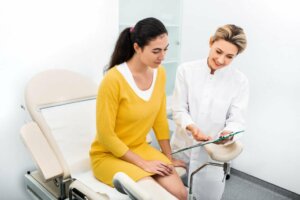Diagnosis of Endometriosis

One of the most complex and common gynecological disorders worldwide is endometriosis. It’s characterized by severe pelvic pain and difficulties in achieving pregnancy. Fortunately, there is treatment available for it. But how do you arrive at the diagnosis of endometriosis?
In order to reach the diagnosis of endometriosis, there’s no test specially designed for it as such. However, self-assessment, physical examination, and some tests (lab and imaging) can go a long way towards doing it. Let’s see a bit more about it below.
Self-evaluation

Knowing the signs and symptoms of endometriosis can be helpful when a gynecological health problem is suspected. However, you must always bear in mind that self-evaluation will never be sufficient to diagnose the disease on its own.
Some of the symptoms that are most taken into account are the following:
- Pelvic (moderate to severe) and lower back pain during the menstrual cycle (not just menstruation).
- Pain isn’t easily relieved by the use of NSAIDs or over-the-counter pain relievers.
- Bleeding or spotting between menstrual periods.
- Heavy menstrual flow.
- Pain when urinating, having a bowel movement, or inserting a tampon.
- Pain during or after having sex (dyspareunia).
It’s important to note that, even when the symptoms don’t remain constant over time, it’s still important to mention them to the doctor. Keep in mind that not all cases of endometriosis are the same, and that symptoms can vary considerably from one woman to another.
Day-to-day observations (on the type of symptoms, intensity, frequency with which they occur, their duration, suspicions of possible triggers, etc.) are all a valuable source of data for the specialist. The more details that can be offered in the consultation, the better.
In the self-assessment, not only pain must be taken into account, but also other symptoms, such as abdominal distention, episodes of diarrhea or constipation, headaches, etc.
Physical examination
In the consultation, in addition to asking questions about pain and other areas of discomfort, the doctor might ask questions about family history, do a physical examination, or order some tests.
As with self-evaluation, physical examination and laboratory tests are often not sufficient to arrive at a diagnosis of endometriosis. In fact, studies indicate that:
“In endometriosis the pelvic examination may be completely normal. However, focal pain or tenderness on pelvic examination is associated with endometriosis in 66% of patients and with pelvic disease in 97% of them.”
Imaging tests
Even though they may have some limitations, there are several imaging tests that can be useful in reaching the diagnosis of endometriosis. Ultrasound, magnetic resonance imaging (MRI), transvaginal ultrasound, and Doppler ultrasound are some of the most common.
Surgical diagnosis of endometriosis

According to the aforementioned study, the author explains that, when diagnosing endometriosis, only signs and symptoms are usually taken into account, as well as ultrasound findings. All this information is usually reliable.
However, there are also invasive methods to obtain samples that allow a doctor to make a diagnosis. The author explains that “the combination of laparoscopy and histological verification of endometrial glands or stroma is considered the gold standard for the diagnosis of the disease”.
Lab tests
Only when ovarian cancer is suspected, might the doctor order blood biomarkers such as the CA-125 test. However, this isn’t common.
Women of reproductive age are more likely to suffer from endometriosis. According to data from the Office for Women’s Health, those in their 30s and 40s are particularly vulnerable.
Differential diagnosis
Given that endometriosis can occur in various ways and that its symptoms can be similar to those of other health problems, a differential diagnosis is necessary. Some of these illnesses and conditions could be pelvic inflammatory disease, ovarian cysts, irritable bowel syndrome, cystitis, fibroids, ovarian cancer, among others.
It must be borne in mind that endometriosis can occur together with other concomitant conditions, as indicated by experts from the World Health Organization. For this reason, it isn’t always easy to quickly reach a definitive diagnosis.
Early diagnosis and timely treatment is the key
An early diagnosis of endometriosis can greatly contribute to the success of the prescribed treatment. For this reason, it’s so important to attend regular gynecological check-ups and avoid downplaying the pain and discomfort that may occur frequently during menstruation.
If you experience severe pain during your menstruation and other symptoms that may force you to suspend your routine activities, it’s best to get a medical check-up and discuss the discomfort in detail with the specialist. The longer you delay the consultation, the longer the discomfort will be and the later you’ll be diagnosed and receive treatment.
Finally, keep in mind that there are women with endometriosis who are asymptomatic. Therefore, you should avoid skipping, and never do without your regular gynecological check-ups.
One of the most complex and common gynecological disorders worldwide is endometriosis. It’s characterized by severe pelvic pain and difficulties in achieving pregnancy. Fortunately, there is treatment available for it. But how do you arrive at the diagnosis of endometriosis?
In order to reach the diagnosis of endometriosis, there’s no test specially designed for it as such. However, self-assessment, physical examination, and some tests (lab and imaging) can go a long way towards doing it. Let’s see a bit more about it below.
Self-evaluation

Knowing the signs and symptoms of endometriosis can be helpful when a gynecological health problem is suspected. However, you must always bear in mind that self-evaluation will never be sufficient to diagnose the disease on its own.
Some of the symptoms that are most taken into account are the following:
- Pelvic (moderate to severe) and lower back pain during the menstrual cycle (not just menstruation).
- Pain isn’t easily relieved by the use of NSAIDs or over-the-counter pain relievers.
- Bleeding or spotting between menstrual periods.
- Heavy menstrual flow.
- Pain when urinating, having a bowel movement, or inserting a tampon.
- Pain during or after having sex (dyspareunia).
It’s important to note that, even when the symptoms don’t remain constant over time, it’s still important to mention them to the doctor. Keep in mind that not all cases of endometriosis are the same, and that symptoms can vary considerably from one woman to another.
Day-to-day observations (on the type of symptoms, intensity, frequency with which they occur, their duration, suspicions of possible triggers, etc.) are all a valuable source of data for the specialist. The more details that can be offered in the consultation, the better.
In the self-assessment, not only pain must be taken into account, but also other symptoms, such as abdominal distention, episodes of diarrhea or constipation, headaches, etc.
Physical examination
In the consultation, in addition to asking questions about pain and other areas of discomfort, the doctor might ask questions about family history, do a physical examination, or order some tests.
As with self-evaluation, physical examination and laboratory tests are often not sufficient to arrive at a diagnosis of endometriosis. In fact, studies indicate that:
“In endometriosis the pelvic examination may be completely normal. However, focal pain or tenderness on pelvic examination is associated with endometriosis in 66% of patients and with pelvic disease in 97% of them.”
Imaging tests
Even though they may have some limitations, there are several imaging tests that can be useful in reaching the diagnosis of endometriosis. Ultrasound, magnetic resonance imaging (MRI), transvaginal ultrasound, and Doppler ultrasound are some of the most common.
Surgical diagnosis of endometriosis

According to the aforementioned study, the author explains that, when diagnosing endometriosis, only signs and symptoms are usually taken into account, as well as ultrasound findings. All this information is usually reliable.
However, there are also invasive methods to obtain samples that allow a doctor to make a diagnosis. The author explains that “the combination of laparoscopy and histological verification of endometrial glands or stroma is considered the gold standard for the diagnosis of the disease”.
Lab tests
Only when ovarian cancer is suspected, might the doctor order blood biomarkers such as the CA-125 test. However, this isn’t common.
Women of reproductive age are more likely to suffer from endometriosis. According to data from the Office for Women’s Health, those in their 30s and 40s are particularly vulnerable.
Differential diagnosis
Given that endometriosis can occur in various ways and that its symptoms can be similar to those of other health problems, a differential diagnosis is necessary. Some of these illnesses and conditions could be pelvic inflammatory disease, ovarian cysts, irritable bowel syndrome, cystitis, fibroids, ovarian cancer, among others.
It must be borne in mind that endometriosis can occur together with other concomitant conditions, as indicated by experts from the World Health Organization. For this reason, it isn’t always easy to quickly reach a definitive diagnosis.
Early diagnosis and timely treatment is the key
An early diagnosis of endometriosis can greatly contribute to the success of the prescribed treatment. For this reason, it’s so important to attend regular gynecological check-ups and avoid downplaying the pain and discomfort that may occur frequently during menstruation.
If you experience severe pain during your menstruation and other symptoms that may force you to suspend your routine activities, it’s best to get a medical check-up and discuss the discomfort in detail with the specialist. The longer you delay the consultation, the longer the discomfort will be and the later you’ll be diagnosed and receive treatment.
Finally, keep in mind that there are women with endometriosis who are asymptomatic. Therefore, you should avoid skipping, and never do without your regular gynecological check-ups.
- Durón González R, Morera PB. Endometriosis. Med Leg Costa Rica Edición Virtual [Internet]. 2018 [cited 2021 Jul 8];35(1). Available from: https://www.scielo.sa.cr/pdf/mlcr/v35n1/1409-0015-mlcr-35-01-23.pdf
- Emilio Fernández O, Jaime Albornoz V. Endometriosis e infertilidad. Rev Médica Clínica Las Condes [Internet]. 2010 May 1 [cited 2021 Jul 8];21(3):403–8. Available from: https://www.elsevier.es/es-revista-revista-medica-clinica-las-condes-202-articulo-endometriosis-e-infertilidad-S0716864010705514
- Endometriosis: MedlinePlus en español [Internet]. [cited 2021 Jul 8]. Available from: https://medlineplus.gov/spanish/endometriosis.html
- Endometriosis [Internet]. Organización Mundial de la Salud. [cited 2021 Jul 8]. Available from: https://www.who.int/es/news-room/fact-sheets/detail/endometriosis
- Endometriosis | Oficina para la Salud de la Mujer [Internet]. [cited 2021 Jul 8]. Available from: https://espanol.womenshealth.gov/a-z-topics/endometriosis
- 1. Ulett Araya NM. Actualización en los puntos clave de la endometriosis. Rev Médica Sinerg [Internet]. 2019 May [cited 2021 Jul 7];4(5):35–43. Available from: https://www.medigraphic.com/pdfs/sinergia/rms-2019/rms195d.pdf
Este texto se ofrece únicamente con propósitos informativos y no reemplaza la consulta con un profesional. Ante dudas, consulta a tu especialista.







